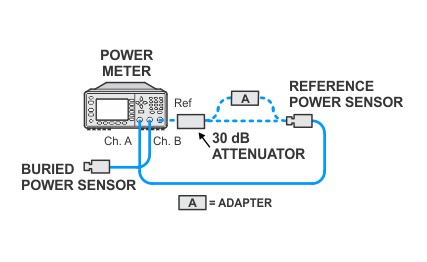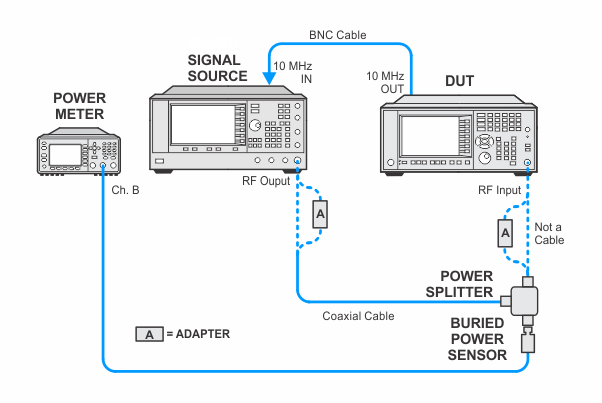
In the following setups, cables are designated as solid lines and direct connections are designated as dashed lines.
NFA — N8974B/75B/76B
Frequency response (aka. Flatness) is defined as the amplitude deviation from the reference amplitude at 50 MHz. The complete analyzer frequency response is measured with several tests.
The model and options of the DUT will determine which tests are run from the list below.
A “buried power sensor” technique is used to characterize the tracking error of a power splitter in order to avoid the relatively large specified tracking error. This technique reduces the measurement uncertainty to verify the frequency-response specification for the 3.6 GHz to 50 GHz range. The buried sensor calibration is valid for four hours.
This test determines the relative frequency response over the frequency range from 3.6 GHz to 50 GHz for Options P08, P13, P26, P43, P44, and P50.
Click here for troubleshooting.
|
Test Equipment |
Recommended Model Number |
|---|---|
|
Microwave Signal Generator #1 |
PSG Models |
|
Power Meter |
N1914B |
|
Microwave Sensor, Low Power
|
8485D |
|
Microwave Power Splitter
|
11667B |
|
Millimeter Power Sensor
|
8487D |
|
Millimeter Power Splitter
|
11667C |
|
30 dB Fixed Attenuator |
11708A |
|
BNC Cable |
8120-1840 |
|
Coaxial Cable, 2.4 mm |
8120-6164 |
|
Coaxial Cable, 3.5 mm |
11500E |
|
Type-N (m) to 3.5 mm (m) adapter |
1250-1743 |
|
3.5 mm (f) to 3.5 mm (f) adapter |
83059B |
|
2.4 mm (f) to 3.5 mm (f) adapter |
11901B |
|
3.5 mm (f) to Type-N (m) |
08485-60005 |
|
|
In the following setups, cables are designated as solid lines and direct connections are designated as dashed lines. |



